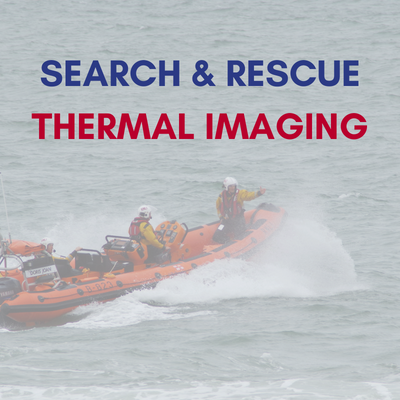
In recent years the number of search and rescue operations is on the rise and have become more high profiled such as the group of boys in Thailand who went missing in the Sea Caves or sea rescues in the Mediterranean Sea saving immigrants from drowning.
With increasing search & rescue operations, it has become important to develop more technology equipment to help find people safely and quicker as time is of the essence in search and rescue operations. Thermal imaging equipment is becoming widely used in search and rescue operations.
Thermal imaging equipment is being used in search and rescue operations for number of reasons. Thermal Cameras can read temperature measurement very easily and display temperature readings as an image or video to users. This is particularly useful when the search and rescue teams can no longer see in darkness at night time or have low visibility. In recent years thermal imaging technology have been integrated onto UAV Drone systems. Thermal Imaging Drones have a lot of benefits in a Search & Rescue (SAR) application, with drones more ground can be covered quickly and easily. This means search areas can be ruled out quickly or can lead to people be rescued very quickly. It also is a much safer way of searching for missing people where areas can be difficult to reach this removes some risks from the rescue teams.
Sea rescue operations are one of the search and rescue missions that would benefit greatly from the use of thermal imaging equipment. The reason for this is due to thermal imaging cameras working from heat/temperature measurement which is radiated from everything and everyone. With sea rescue operations, the sea temperatures help people to be found easier because of the difference between sea and human temperature. If we look at the Atlantic Ocean sea temperatures can range from −2 °C (28 °F) to over 30 °C (86 °F). While average human temperature is 98.6°F (37°C). Even a difference of 7 degrees from 30°C to 37°C could crate a big difference on a thermal image or video recording.
Mountain rescue teams often have to search dangerous tough terrain for missing people. A thermal imaging UAV drone system or a fixed thermal camera fitted to a rescue plane/helicopter can cover this type of terrain easily and quickly without causing harm to search and rescue workers. This can rule out areas where there is no sign of people before sending out the search teams. This means search teams won’t run out of energy quickly and with an aerial survey by the thermal drone they will know what type of terrain they will be searching and be able to make the correct preparations for ground searches.
We have two different range of thermal imaging cameras that would be suitable to use in a Search & Rescue Situation. The first is a thermal handheld monocular called the UMTI which is easy to use and features video and still recording with a 384x288 IR Resolution. This is suitable for rescue teams that are searching on the ground.
The second is our UAV drone system, the 640P which has a UFPA 640x480 detector which is a high-quality detector which will deliver clear, crisp thermal images and video to the end-user. It has electric and auto focus up to 50m. The FOV is 12°x9° and spatial resolution (IFOV) of 0.34 mrad. However, due to it’s IP rating of IP43 it is recommended to fly this only in dry conditions and max wind resistance is 10m/s. The benefit of using a thermal UAV Drone system is that it can cover more ground easily and quickly which speeds up the process of searching for the missing people.